November 8, 1924 Centre vs. Tennessee
Centre and the University of Tennessee had played seven times over the years, with the first game in 1905. Tennessee held the edge, 3-2-2.
On October 2, 1909, when Centre's team was known as Central University of Kentucky due to the college's consolidation with Central University of Richmond, Kentucky, Central and Tennessee played to a 0-0 tie.
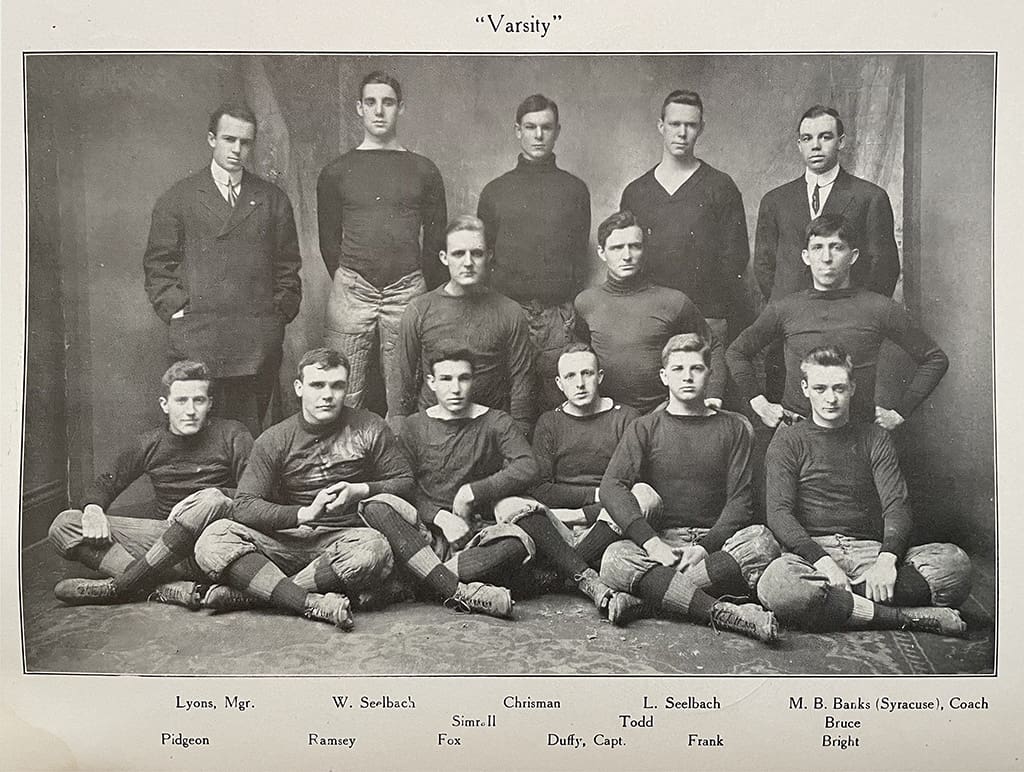
The 1909 Central University of Kentucky ( Centre ) team
The Seelbach brothers were on the team. The coach, M.B. Banks, top right, was later the coach at the University of Tennessee when Centre played Tennessee in 1924. The Seelbach brothers were the sons of Louis Seelbach, who with his brother, Otto, was the co-founder of the Seelbach Hotel in Louisville. William, top row, 2nd left, was a freshman and Louis, top row, 2nd right, was a junior. Centre utilized the Seelbach Hotel, Louisville's finest when it was constructed in 1905, as its headquarters during the 5 years that the Colonels played in the city, 1919-1923. Louis Seelbach was later a Centre Board Member, and along with his brother William, was inducted into the Centre Athletic Hall of Fame in 1998. ( Many still consider the Seelbach, Louisville's finest hotel. )

Wait Field was the site for Tennessee football until 1921. "Central Univ. of Kentucky" is explained below.
We need to discuss the relationship between Centre and Central University of Kentucky because it is either misunderstood or not even known about to this day. So, bear with me for a minute.
It is a bit complicated, but I feel I can clarify it.
A new school named Central University of Kentucky was chartered in 1873 and opened in 1874 in Richmond, Kentucky, 35 miles east of Danville. It came into existence due to a rift within the Presbyterian Church which began during the Civil War resulting in the 1861 creation of Northern and Southern factions of the church, with the Southern Presbyterians becoming members of what was called the Presbyterian Church in the Confederate States of America, PCCSA, which later was known as the Presbyterian Church in the United States, or PCUS. It was like the War had created another battlefield and even after the fighting ended in 1865, it continued in the pews.
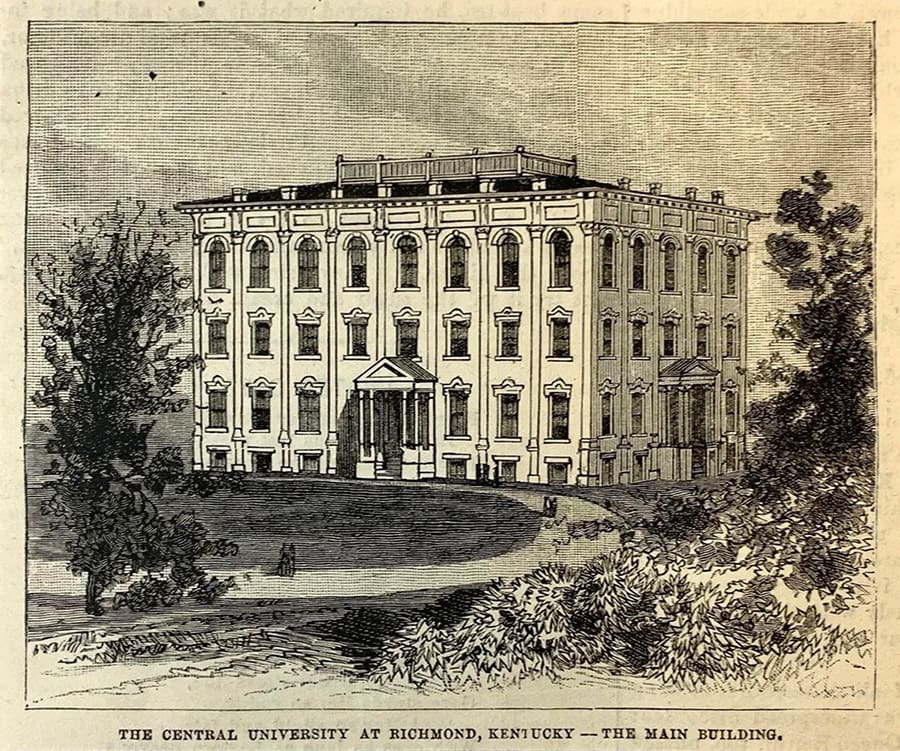
The newly created Central University of Kentucky which was established by divisions resulting from the Civil War
Primarily, those associated with Centre had wanted to retain its association with the Northern Church. The Richmond breakaway group, which had sided with the Southern Church, created a ( 1 ) College of Letters, Philosophy, and Science, ( 2 ) a College of Law, also in Richmond, ( 3 ) a medical school in Louisville, ( 4 ) a dental school also in Louisville, and 4 prep schools located in Middlesboro, Jackson, Elizabethtown, and Richmond.
( The Northern church, or Presbyterian Church in the United States of American, PCUSA and the Southern Presbyterians, united in 1983 and are now joined as the United Presbyterian Church in the United States of America, UPCUSA. However, it took 122 years for those good Christians to resolve their differences! )
Central University fielded a football team at its campus in Richmond.
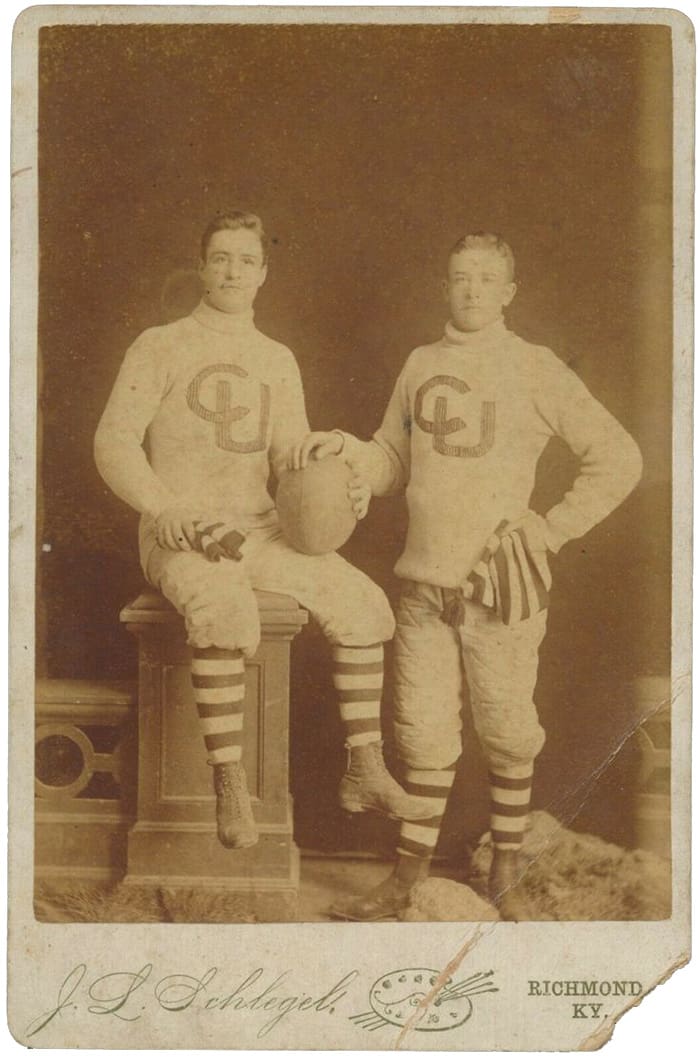
Cabinet photograph of Central University of Kentucky players S.P. Scott and Bob Adams in the 1890's. The footballs of the era somewhat resembled a watermelon. In 1906, the ball was reshaped in order to make it easier to pass, a reflection of the new rules which were mentioned in Chapter 11.
Central University ran into financial difficulties almost from the onset and in August 1891 it was legally consolidated with Centre College. By 1901, it was agreed that its campus should also be actually physically consolidated with Centre, and Central, including its law school, was moved to Danville. The newly joined Richmond and Danville schools went by the Central University of Kentucky name. It was somewhat confusing to people. As you can see below from the newspaper clipping, there was now, "The Centre College and Central University at Danville."
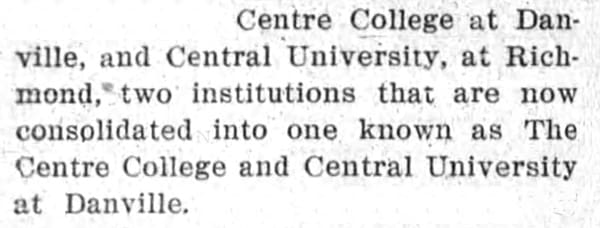
Below, in a 1906 advertisement for Central University of Kentucky, there were 4 colleges listed, one of which was Centre College. I think the best way to understand the situation is that Central University was the umbrella, organizational name after the 1901 consolidation and Centre basically maintained its individuality as one of the 4 colleges, at least academically.

A 1906 advertisement for Central University of Kentucky. It lists 4 colleges. The College of Law was closed in 1911. The medical and dental colleges eventually were absorbed into the University of Louisville.
When Central University was moved to Danville, the buildings of what had been Central University in Richmond were vacated for several years. Kentucky's governor, J.C.W. Beckham, who had attended Central University, formed a commission in March 1906 to look at possible locations for two new "normal schools," or teacher's colleges, for the state. Richmond's civic leaders began to campaign for it to become the site of one of the new schools utilizing the old Central University of Kentucky campus.
On April 25, 1906, Richmond's mayor published a "Proclamation" in the Richmond "Climax" newspaper for the citizens to clean up the town by getting the yards mowed, trees and hedges trimmed, fences repaired and painted, trash removed and generally tidying up the city in order for the visiting commission to have a positive impression regarding the desirability of the town as a location for one of the new colleges.
The efforts must have been successful because on May 7, 1906, Governor Beckham signed legislation establishing the new Eastern Kentucky State Normal School Number 1, which eventually evolved into the present day Eastern Kentucky University. It was decided to use "Maroons" as the nickname for Eastern Kentucky State Normal as the new state school's colors were maroon and white.
That same 1906 legislation designated Bowling Green to be the location of the new Western Kentucky State Normal School Number 2, which is now the Western Kentucky University "Hilltoppers."
Centre's athletic teams prior to 1901 had been referred to as "Old Centre," or the "Gold and White," the colors for the college.
Centre's yearbook was called the "Ec Centric" before the 1901 consolidation.

Centre's 1898 "Ec Centric"
Central University's yearbook was published as the "Cream and Crimson" while the college was in Richmond.
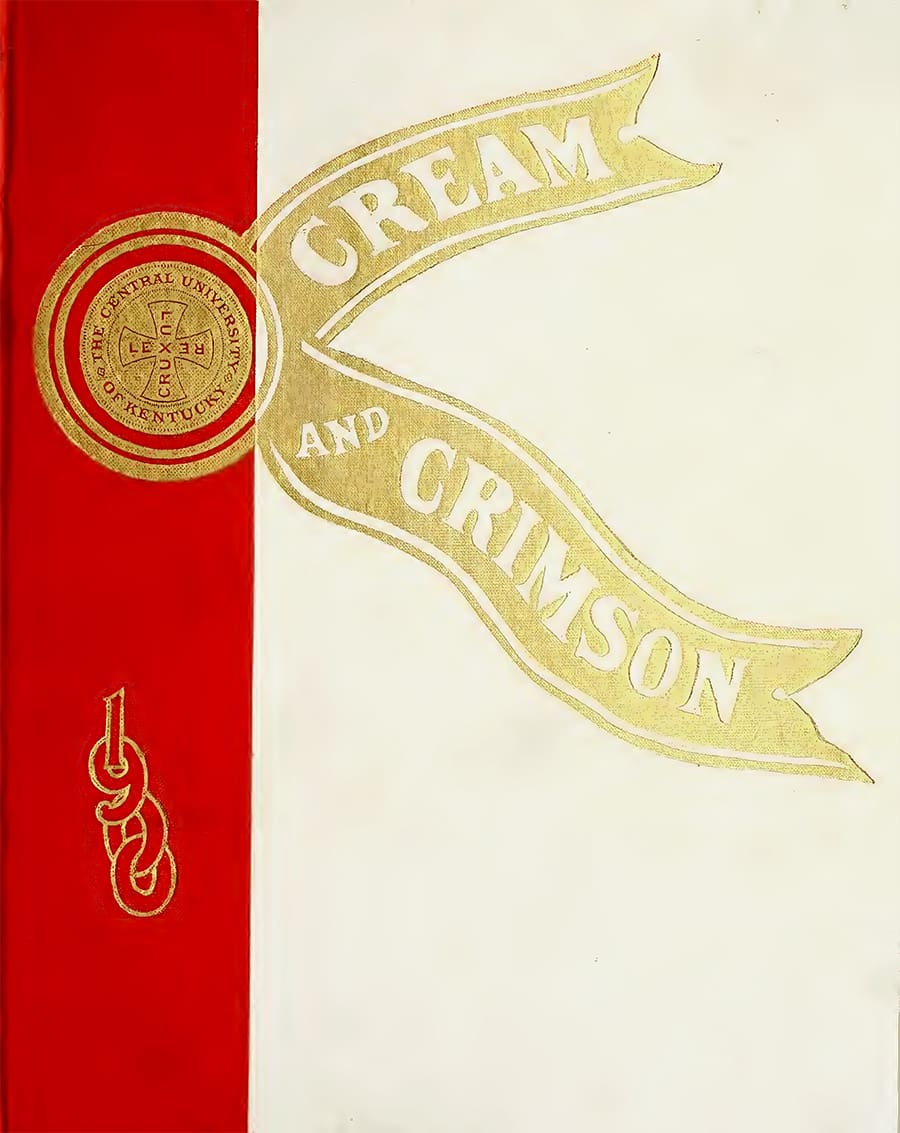
1900, the last year of the Central University "Cream and Crimson"
All of that changed after the consolidation of the two colleges.
The Centre athletic teams began competing under the Central University of Kentucky name. The yearbook of the consolidated schools became the "Cardinal and Blue." The athletic teams of the newly formed institution began being known as the "Cardinal and Blue," as those were now the school's colors. There was no more "Gold and White" or "Cream and Crimson."

The 1903 yearbook published in Danville for the consolidated schools. Note that the circular emblem now has both "Central University of Kentucky*1874-1901*" and "Centre College of Kentucky *1819*" embossed.
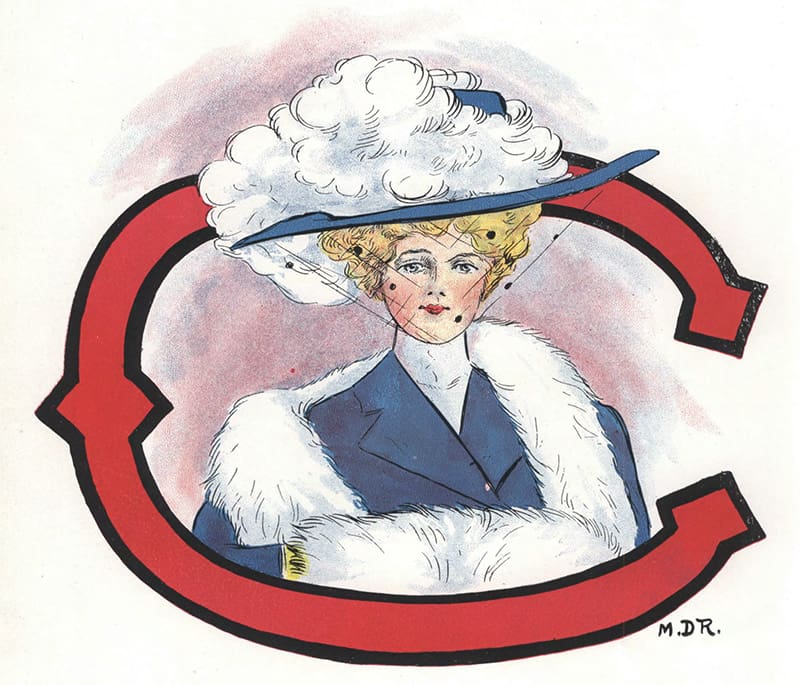
An illustration from the "Cardinal and Blue" yearbook of 1909 utilizing the school's colors of cardinal and blue
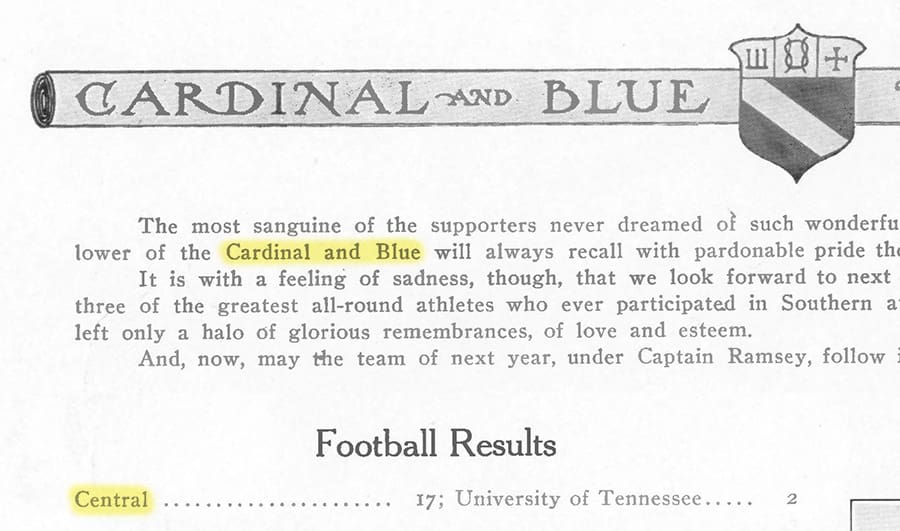
From the 1910 "Cardinal and Blue" yearbook. The football team was referred to as the "Cardinal and Blue" and played under the "Central" name as highlighted.
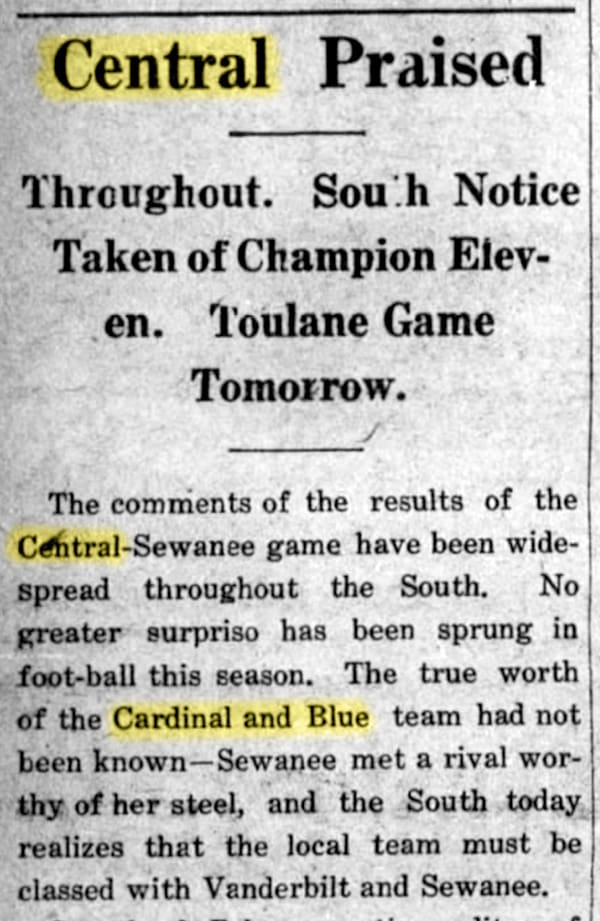
Story from October 25, 1910 Danville "Messenger" revealing that "Central" was being utilized along with "Cardinal and Blue."

Murad tobacco card from 1910 showing the Cardinal and Blue colors. The "1519" is a misprint of the 1819 founding of Centre. "1874" was the first year for the operation of Central University of Kentucky in Richmond, Ky., and the "1901" was the date of the consolidation of the two colleges on the Danville campus.
Centre remained officially a part of Central University for 18 years after the 1901 consolidation, governed by a 24-member board, half of which were appointed by the Northern Church and half by the Southern. The law school closed in 1911 and the medical and dental schools were spun off into the University of Louisville.
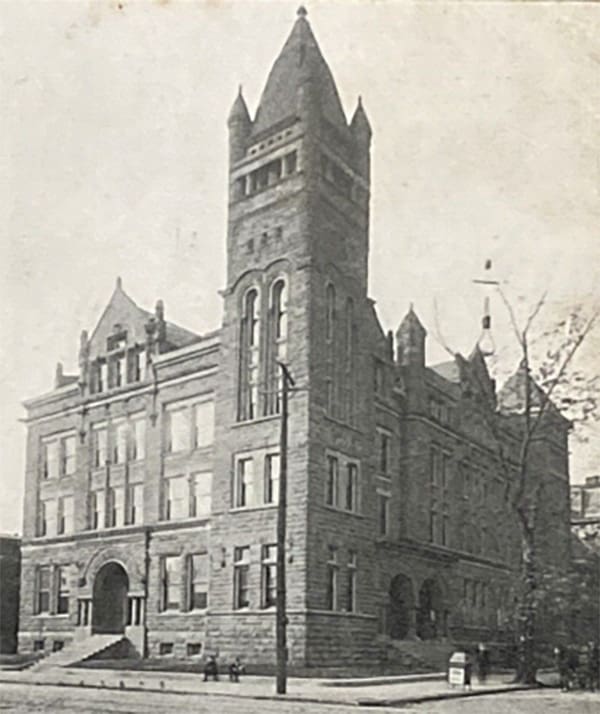
University of Louisville School of Medicine

University of Louisville School of Dentistry
Central University was left with only Centre College as an entity. As seen in the October, 1915, Danville "Messenger" story, the college was still being referred to as Central University, but that would soon end.

Still Central University in 1915
In 1915, the last "Cardinal and Blue" was published and the 1916 yearbook became "Old Centre." The school had dropped the "Cardinal and Blue" nickname entirely, including for the football team.
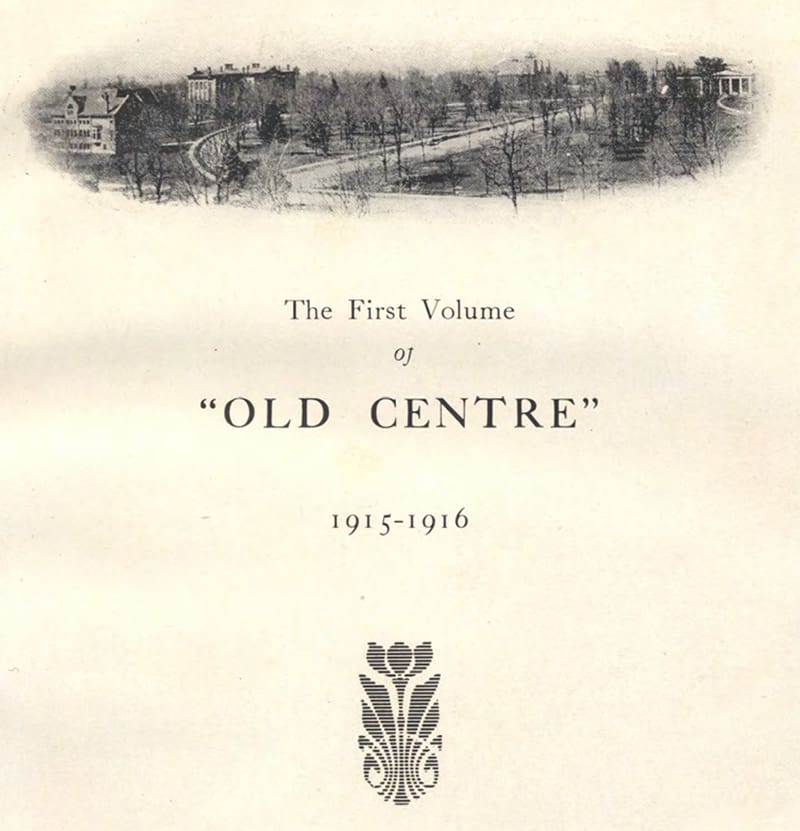
The first year that the yearbook was "Old Centre." The spelling was changed to "Olde Centre" in 1931.
When Centre decided to stop using "Cardinal and Blue," it began to start using just Centre exclusively rather than any mention of Central University. A discussion then followed about whether the old "Gold and White" nickname should now be officially resurrected or some other designation should become synonymous with Centre.
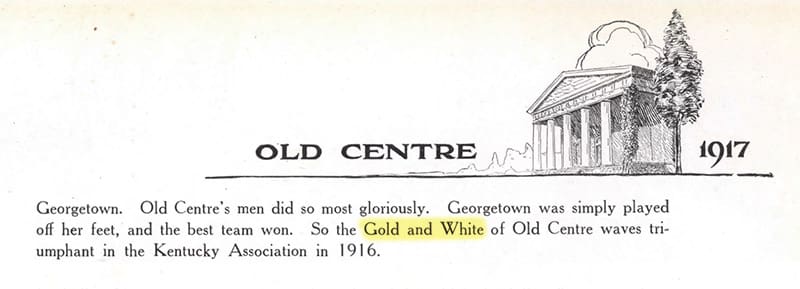
In the 1917 "Old Centre" yearbook, it was the "Gold and White" in describing the win over Georgetown in 1916.
George Joplin, a Centre student and newspaper reporter, proposed using "Colonels" when referring to its teams. He felt that the name, "commands respect, it is indicative of a gentlemen, yet one who will fight if he has to."

George Joplin, Centre '20, a very involved young man from Somerset, Kentucky, who among numerous activities, was a "correspondent for five out-of-town papers."
It was agreed that "Colonels" would be an excellent nickname and Centre College "Colonels" began to be used when discussing the college's athletic teams, but the "Gold and White" was retained and continued to also be used, as it is somewhat to this day.
The first time that it can be documented for certain when Centre became the "Colonels" was in March, 1917. The name was included in a story in the Danville "Messenger" about the basketball team.


Mention of "Colonels" in the March 6, 1917 story appearing in the Danville "Messenger"
Later, in November, 1917, the name was being used regarding the football team.

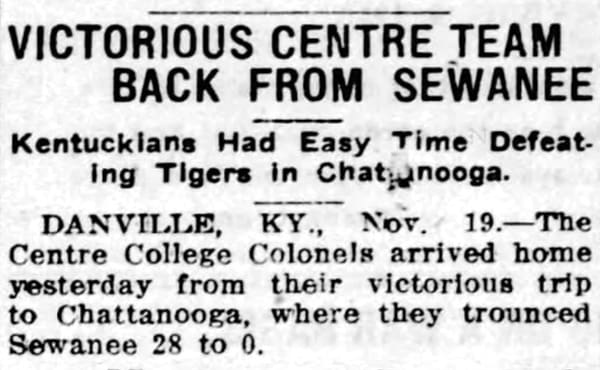
Centre College "Colonels"
Since George Joplin was a "correspondent for five out-of-town papers," including the Lexington "Leader," it would seem almost certain that he wrote the story in the "Leader" which mentioned "The Centre College Colonels." After all, it was "Jop" who had proposed the use of the name in the first place and he would have wanted it to be perpetuated.
In 1918, the Kentucky State Legislature abolished the Central University of Kentucky name, and once again, Centre officially was simply-Centre College.
"Central University of Kentucky" and "Cardinal and Blue" were now history.
All seemed resolved. Centre was again just Centre and Centre was the Colonels.
( The "Praying" nickname was also first introduced in 1917 following the story about the team praying before the November 3, 1917 game with the University of Kentucky which Centre won, 3-0. See Chapter 2. )
However, over 4 decades later, a little problem arose. It wasn't earth shattering but rather simply perplexing.
The belief that "possession is nine-tenths of the law" was apparently not how the folks at Eastern Kentucky State College over in Richmond felt about Centre being the only "Colonels." In 1963, Eastern Kentucky's president, Robert Martin, decided to shelf the school's "Maroons' " nickname. Of all of the many thousands of possibilities of new nicknames for his college, he settled on "Colonels."
( Eastern Kentucky State College became Eastern Kentucky University in 1966. )
Apparently, Dr. Martin felt, as George Joplin had earlier, that the name commanded respect and was indicative of a gentleman. There can only be speculation about how much of a gentleman one is when they appropriate somewhat else's school nickname as their own.
At least Eastern didn't abscond with the "Praying" part of the "Praying Colonels!"
That is why for 60 years now, there have been the Eastern Kentucky Colonels and Centre College Colonels.
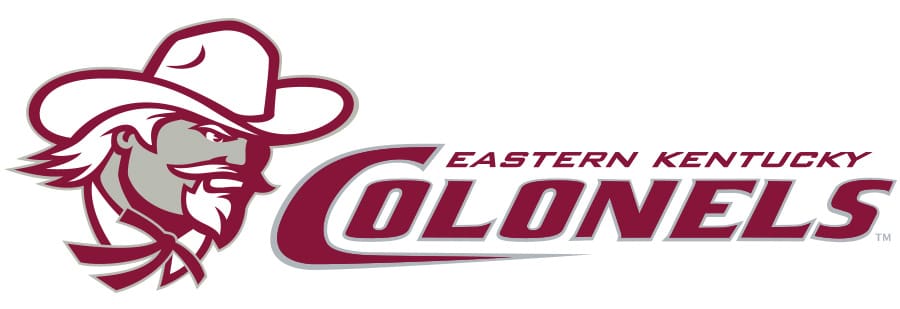
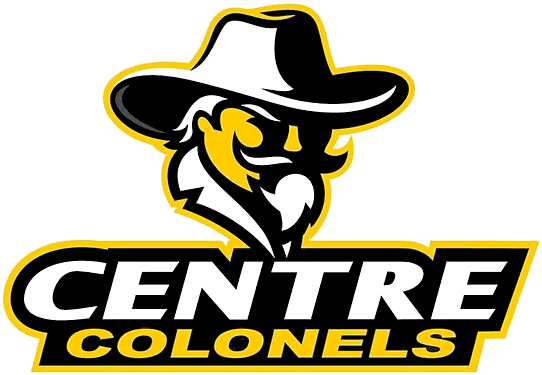
Might there be a bit of similarity here?
One more point.
A significant takeaway to remember is that any time you read about Centre College and its football teams being referred to as Central University from the 1901 consolidation onward, as it was on the above 1909 program cover with Tennessee, any records such as those of the football team are part of Centre's all-time, official statistics.
That needs to be remembered.
So, having navigated through that rather arduous detour, let's get back on the road to Centre and Tennessee.
We were discussing the 1909 Tennessee game before getting into the Central University of Kentucky situation.
The following year, 1910, Central beat Tennessee 17-2 in an undefeated 9-0 season. It was a great year in which Central only gave up 13 points.
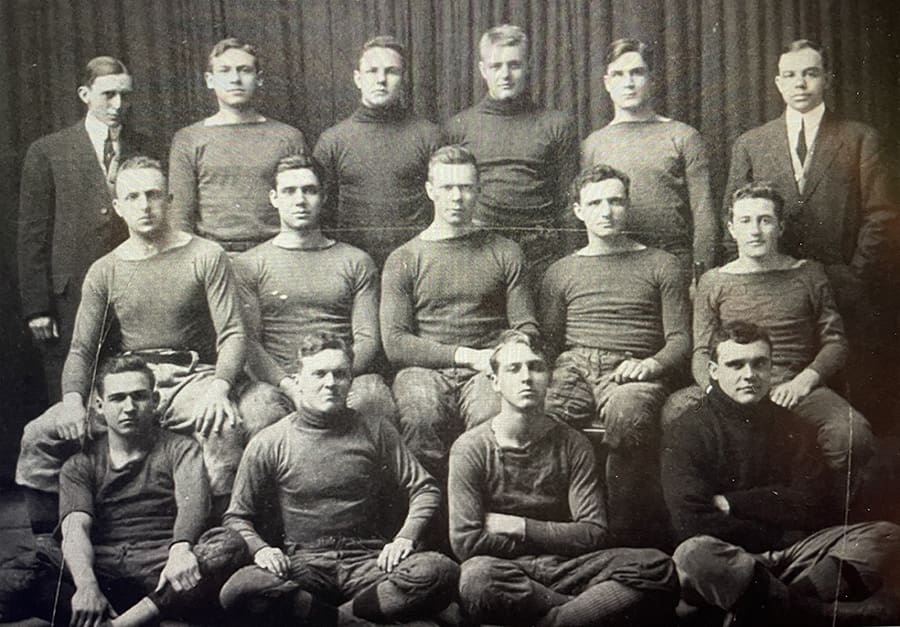
The undefeated 1910 team with William Seelbach, 2nd left, and Louis Seelbach, 3rd left, on middle row. Coach Banks is top, right.
1910 CENTRAL SEASON RECORD
Central 17 Tennessee 2
Central 12 Miami ( Oh. ) 2
Central 19 Sewanee 0
Central 33 Hanover 0
Central 35 Tulane 0
Central 27 Transylvania 0
Central 12 Cincinnati 3
Central 78 Georgetown (Ky.) 0
Central 12 Kentucky 6
The last two games the two teams had played were held in the pre-Uncle Charlie Moran era and resulted in Central being smashed, 67-0 in 1912, and 80-0 in 1915. However, now, with Uncle Charlie at the helm, things had changed in a major way.
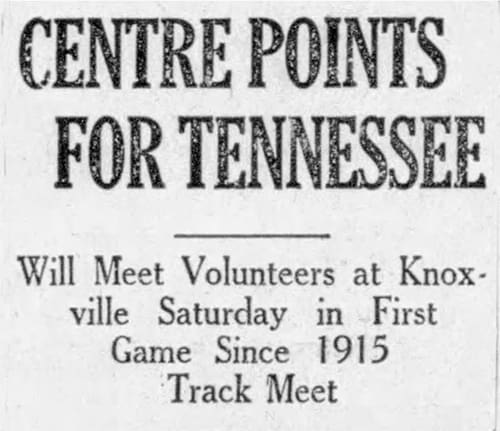
The "Track Meet" of 1915 was the 80-0 beating that Tennessee had inflicted on the Gold and White during the last meeting between the two teams.
The Volunteers were coached by M.B. Banks who had been Central University of Kentucky's coach from 1909-11 after playing at Syracuse. ( See the above photographs of the 1909 and 1910 Central University teams. ) Banks had previously been at Drake from 1918-1920 and came to Knoxville to take over the program there in 1921. He had compiled a respectable 22-10-2 record going into the game with Centre.
Banks squad was 3-2 and his team hadn't fared well in its last game, a 33-0 loss to Georgia.
Tennessee 27 Emory and Henry 0
Tennessee 28 Maryville 10
Tennessee 13 Carson-Newman 0
Tennessee 2 Mississippi A&M ( State ) 7
Tennessee 0 Georgia 33
Home games were played at Shields-Watkins Field on 15th Street which was located along the Tennessee River. The stadium was concrete and had seating for only 3,200 spectators, but several more thousand could be accommodated by purchasing standing room tickets and lining the field, as was the habit when an attractive opponent was in town such as Centre.
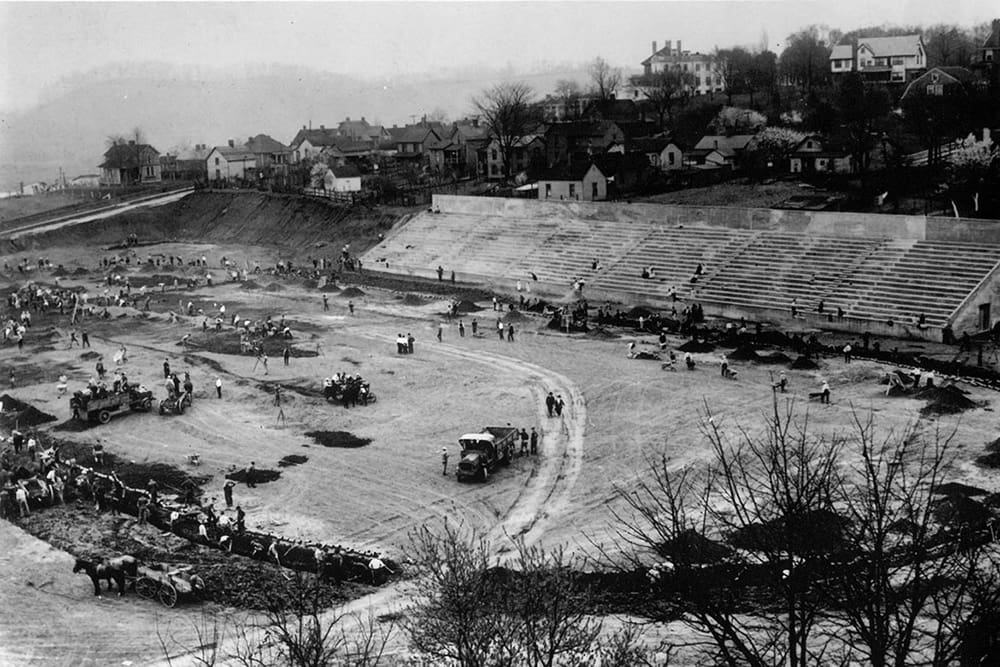
Shields-Watkins Field with the stadium just completed and the field being prepared in 1922. 700 students volunteered to level the surface, install drainage tiles, and get the ground seeded. Tennessee has played football on this site now for over a century with multiple expansions beginning in 1926. In 1962, the stadium was renamed Neyland Stadium in honor of General Robert Neyland, who built the Vols into a national power during his years as coach during three different periods from 1926-1952. The name of the playing surface remains Shields-Watkins Field and it now is the site of the 6th largest stadium in the country with a capacity of 101,915.
The Tennessee River can barely be seen on the far left with the houses overlooking the cliff with the distance hills beyond.
Centre arranged for a chartered Pullman to be picked up by a Southern passenger train originating in St. Louis which didn't come through Danville until 11:30 P.M. The advantage of having a chartered sleeper was that since the train hit Knoxville very early in the morning, the Colonels' car could be left on a siding at the Southern Railroad Station and the players could sleep until a civilized hour.
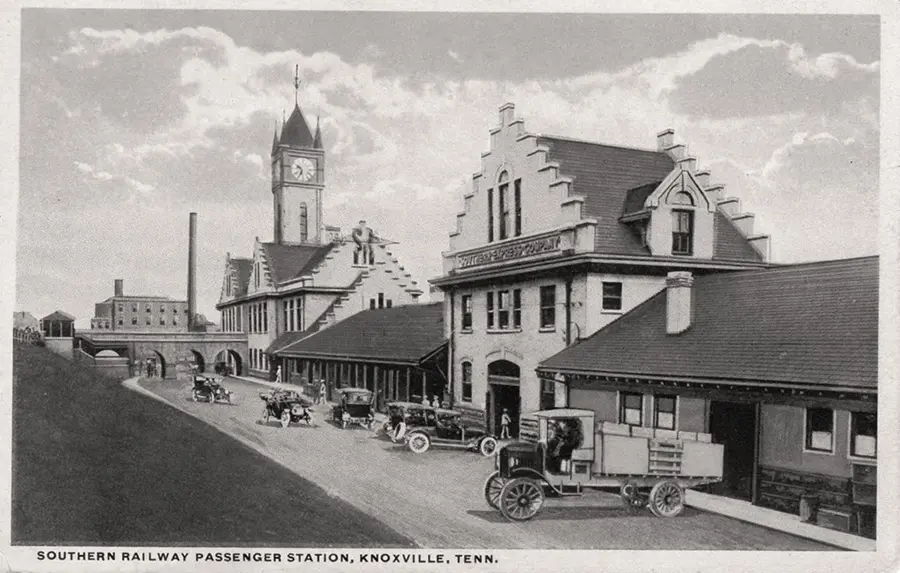
Southern Railroad where the team stayed on their Pullman until going across the street to the Hotel Atkin for breakfast before the game
They would return after the Saturday game, connected to a northbound Southern train which came straight through Knoxville in the early evening.
The late departure from Danville meant that for the first time anyone could remember, there wasn't a boisterous sendoff at the station. It was nearing midnight, and only a few of the most ardent fans made it down to the station, understandably.
Centre didn't expect Tennessee to present much of a challenge. The Chief got Red Roberts to talk to the injured Frank Rubarth and Bob Wallace about them not going to the game.
Red and I went together to talk to Frank. Bob Wallace had his hand in a big cast and there was no way that he could play, and he understood. But Frank was different. He felt it was a matter of honor to go and to play. He'd made a pledge.
But, Red was great. He explained that the team really needed him for Alabama and Georgia. He said, "Frank, do you love this team?"
And Frank said, "Of course, Red. How could you even ask something like that?"
Red said, "If you love the team, you'll get healed and be ready for the games when your teammates really need you. By the Alabama game, it will be three weeks since you broke your collar bone against West Virginia. I'll guarantee you'll be fine by then. But if you go to Tennessee and re-injure your shoulder, you'll let the team down."
So Frank said he understood, and he and Bob didn't even go and take up a berth on the train. They said that a couple of the other guys who didn't normally get to go on the trips should be taken along.
Everything worked out for the best. The Chief was a great man, and everybody just loved him. And they all liked Coach Ofstie. But it seemed like if there was ever a problem, like Frank not playing, Red would be asked to see what he could do, and always, Red worked things out.
Not that there were many problems, or a lot of things to work out.
Of course, I went to the game in Knoxville. As freshman manager, I was now part of the "official party."
The morning of the Tennessee game found the Colonels in Knoxville with several hours free before needing to get to the game. The team had reserved a dining room at the Hotel Atkin directly across from the Knoxville Southern Station.

Hotel Atkin, Centre's morning headquarters
I was there there at the breakfast.
After the guys had placed their orders, Hennie Lemon stood and got the attention of everyone by clanging his water glass with a spoon.
"Chief, we want to bring up a very serious and important subject."
The Chief was caught a bit off guard, but said, "You have the floor, Mr. Lemon."
Hennie pulled an issue of a newspaper out of his coat pocket and began to unfold it.
"Would you say, Chief, that Coach Knute Rockne has done an excellent job at the University of Notre Dame over the past several seasons?"
"Yes indeed, Hennie."
"I think we all would agree, Chief. Do you know what has made him so successful?"
The Chief was getting into the spirit as he saw several of the players begin to smile. He didn't know just what was coming, but he knew it must be amusing.
"I'm certain you're going to tell me, Hennie."
Lemon glanced at the newspaper and then held it up.
"Chief, it says here that- just let me read it, and I quote- 'Knute Rocke, the coach of the Notre Dame team which has had much success, is said to have taken members of the team to a musical comedy to watch the cooperation of the kickers in the chorus. He declares a team's members must work together with a harmony approaching the rhythm of chorus girls,'- end quote."
Herb Covington stood.
"Chief, as the captain of the team, I must state that I felt we were a little out of rhythm at the Kentucky game. I think we need to work on our rhythm, and we're willing to go to Lexington or Louisville or even back to New York to watch some chorus girls. We'll go anywhere to take rhythm lessons."
Carl Hilker, a substitute end, hopped up.
"Chief, I've never felt so bad about anything in my life as how out of sync us subs seemed on the bench during the Kentucky game. When I went in for Hennie, it was really hard for me to get into the rhythm of the game."
By now, everyone was beginning to break out laughing, the Chief included. Then he got a real stern look and said, "You want rhythm? You want rhythm? Everybody on your feet! Now. Left leg up, right leg up, turn- a -round. Come on, Hennie. Come on Covey. Let's see it Carl. Left leg up, right leg up, turn- a- round."
The Chief couldn't keep a straight face as he began to kick his legs up.
"Left leg up, right leg up. Turn-a round. Left leg up. Right leg up. Turn-a-round."
It was an unbelievable scene! The waitresses almost dropped their trays as they came through the swinging kitchen doors. Some of the Colonels were trying to do little pirouettes on their toes, hands clasped over their heads. Others were doing leg kicks. All were laughing so hard that they had tears coming down their cheeks. If anyone ever let the ladies in on the joke, it wasn't known. One can only hope someone did.
The game was played on a Saturday afternoon in weather which wasn't atypical for November along the Tennessee River. The field was wet but the rain had stopped. A haze and finally overt fog had rolled in off the river. The conditions weren't a bother for the Colonels. They won easily, beating Tennessee by one less point, 32-0, than Georgia had in Athens a week earlier.
Herb Covington primarily stuck to the ground. Junior halfback Elmer Rabenstein carried the load the majority of times. The Knoxville papers declared that "Roundy" was "the greatest back who had ever played on Tennessee soil." Rabenstein capped off a great afternoon by scoring the final touchdown on a 67 yard run, his second score of the game.

Elmer "Roundy" Rabenstein who carried the load in the Tennessee game
Minos Gordy bulled in for two TDs, Covey took it in once, and Lemon kicked two extra points.
Centre played only 13 men. James Priest started in the place of Rubarth and shared time at the guard slot with Bill Kagin. Carl Hilker spelled Lemon late in the game.
As Hennie Lemon trotted off, he came over to the sideline smiling and said to the Chief, "I think we got our rhythm down this afternoon. No more exercises!"
It had been a very business-like win over an outclassed but game foe.
Centre was 3-1-1. The team, and especially "The Immortals," was halfway to its goal of being recognized as the "Class of the South."
However, two big challenges stood in the way- the University of Alabama and the University of Georgia.
I was out on the field every day at practice. We all recognized that beating the Southern schools had become an obsession. The practices were as intense, or even more so, than the games. It wasn't that the coaches were driving the team so hard. It was the team that was driving itself almost brutally.
After the hardest of practices, all of the players would be out on the field running extra laps until they'd almost drop. They were led by "The Immortals." Covey would spur them on, but it didn't take much spurring, because they all wanted to outwork each other and prove by their work that they could literally will themselves to win.
That's what Red and I decided. They were going to will themselves to win. We'd stand on the sidelines and marvel at how hard they practiced.
Red told me that he thought that this team was as good as any Centre had ever put together. Certainly they were as dedicated.
